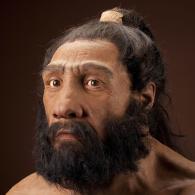
The first people[1] were not people, strictly speaking.
The first people were almost modern humans. Scientists do classify these early folks as member of the genus Homo, but they were not quite members of our species, the modern humans. We named ourselves Homo sapiens, “the man who knows,” but even though Linnaeus described us scientifically in 1758, there is not a specific “type” and there is not a prime example of how we look.[2] We come in all sizes, shapes and hues.
We call some of our predecessors Homo neanderthalensis[3] after the Neander valley in Germany where we first discovered their bones. They migrated out of Africa long before “the man who knows,” and they settled in what is now Europe. Neanderthals controlled the vital element of fire. They wore clothing and they built shelters to live in. They were skilled hunters but their diets included plants. Their brains were larger than our own. They left traces of an artistic culture, and they crafted ceremonial burial sites for their dead. These “cousins” of ours were the first primates to behave in these human ways. Neanderthal DNA shows that they did not belong to our species; despite that their DNA is 97% the same as ours.
There is also evidence that the earliest modern humans in Asia interbred with Denisovans[4] who were similar in stature and culture to Neanderthals. There is even a likelihood that “the man who knows” did, in fact, combine his DNA with Homo erectus,[5] our first ancestor to migrate out of Africa. These were our first predecessors to possess bodies shaped like ours and to assume erect postures like our own.
Popular scientific theory has held for decades that all three of these precursors to us were dead-end species. They died out, we were taught, or they were driven out and conquered by “the man who knows” or by another modern type, the Cro-Magnon man.[6]
We now know that the genetic make-up of every human alive today (except for Africans) includes 1% to 3% of his or her DNA from Neanderthal or Denisovan inheritance. We didn’t conquer Neanderthals. We mated with them. My DNA is 3.2% Neanderthal. I’m above average in my caveman ancestry! (Africans do not have Neanderthal genetic inheritance, since the inter-breeding occurred after the “pre-modern” humans and the “modern” humans migrated out of Africa.)
We are all descended from original humans in Africa. We all contain DNA from “people” who were not the same exact genetic composition as us. We are all cousins to a degree. We are all hybrids!
No matter our size or shape or hue, we are all related.
Image: Male Neanderthal reconstruction based on Shanidar 1. Image Credit: John Gurche, artist / Chip Clark, photographer
[1] PBS series “First Peoples” see: http://www.pbs.org/first-peoples/home/
[2] See: http://humanorigins.si.edu/evidence/human-fossils/species/homo-sapiens The Smithsonian National Museum of Natural History on “What Does it Mean to be Human?
[3] See: http://humanorigins.si.edu/evidence/human-fossils/species/homo-neanderthalensis
[4] See: http://www.sci-news.com/othersciences/anthropology/science-denisovans-homo-species-interbred-modern-humans-01476.html “Mysterious Homo Species Interbred with Modern Humans in Australasia,” Oct. 20, 2013, Sci-News; see also: http://archaeology.about.com/od/hominidancestors/qt/Denisovans.htm “The Denisovans: The Third Human Species” by K. Kris Hurst
[5] See: http://humanorigins.si.edu/evidence/human-fossils/species/homo-erectus
[6] See: http://humanorigins.si.edu/evidence/human-fossils/fossils/cro-magnon-1